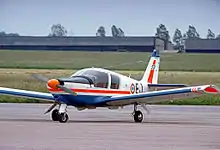| Robin HR.100 | |
|---|---|
.jpg.webp) | |
| Robin HR.100/250TR Tiara aircraft D-EKRF, at Lelystad Airport (EHLE), 22 May 1993 | |
| Role | Four-seat light monoplane |
| National origin | France |
| Manufacturer | Avions Pierre Robin |
| Designer | Chris Heintz |
| First flight | 1969 |
| Produced | 1969-1976 |
| Number built | 178 |
| Developed from | Robin DR.200 |
The Robin HR100 is a French four-seat light monoplane, designed by Chris Heintz[1] and built by Avions Pierre Robin as metal-winged version of the Robin DR253 Regent.
Development
The prototype of the Robin HR100 was the prototype DR253 Regent which was rebuilt with metal wings and powered by a 180 hp (134 kW) Lycoming O-360 engine. It first flew on 3 April 1969 as the Robin HR100/180. The HR100 is a low-wing cantilever monoplane with a conventional cantilever tail unit and a fixed tricycle landing gear. A number of different variants were produced in the 1970s. From 1972 a high-powered improved version was produced as the HR100/285 with a 285 hp (213 kW) Continental Tiara 6-285B engine and retractable landing gear and airframe modifications.

The French Air Force ordered a number of HR.100/250 aircraft in the mid 1970s and these were used for communications and other duties.
A two-seat trainer version was developed as the HR200, and a modified version with a lighter airframe and new fin and rudder was developed as the R1180 Aiglon in 1977.
Variants
- HR.100 Royal
- 1969 Prototype with a 180hp (134kW) Lycoming O-360 engine, one built.
- HR.100/180
- 1976 Prototype with a 180hp (134kW) Lycoming O-360 engine, one built.
- HR.100/200B Royal
- Initial production version with a 200hp (149kW) Lycoming IO-360 engine.
- HR.100/210 Safari
- Production version with a 210hp (157kW) engine, 113 built of both 200B Royal and 210 Safari variants.
- HR.100/235TR
- Experimental HR.100 with an enlarged tail and retractable landing gear and a 235hp Lycoming O-540-B engine, one built.
- HR.100/250TR
- HR.100/235 with a 250hp (186kW) Lycoming IO-540-C4B5 engine, 24 built.
- HR.100/285TR Tiara
- HR.100/235 with a 285hp (213kW) Continental Tiara 6-285 engine, 37 built
- HR.100/320 4+2
- Experimental version with two extra children's seats, one built
Operators
Military operators
Specifications (HR.100/285)
Data from Jane's All the World's Aircraft 1976–77[2]
General characteristics
- Crew: 1
- Capacity: 3–4 passengers
- Length: 7.59 m (24 ft 11 in)
- Wingspan: 9.08 m (29 ft 9 in)
- Height: 2.71 m (8 ft 11 in)
- Wing area: 15.20 m2 (163.6 sq ft)
- Aspect ratio: 5.36:1
- Airfoil: NACA 64A515 (modified)
- Empty weight: 840 kg (1,852 lb)
- Max takeoff weight: 1,400 kg (3,086 lb)
- Fuel capacity: 440 L (97 imp gal; 120 US gal)
- Powerplant: 1 × Teledyne Continental Tiara 6-285 flat-six, 213 kW (285 hp)
- Propellers: 3-bladed Hoffmann wooden constant-speed propeller, 2.00 m (6 ft 7 in) diameter
Performance
- Maximum speed: 325 km/h (202 mph, 175 kn) at sea level
- Cruise speed: 293 km/h (182 mph, 158 kn) (65% power)
- Stall speed: 110 km/h (68 mph, 59 kn) (flaps down)
- Never exceed speed: 360 km/h (220 mph, 190 kn)
- Range: 2,344 km (1,456 mi, 1,266 nmi) (econ. cruise)
- Service ceiling: 5,700 m (18,700 ft)
- Rate of climb: 6.0 m/s (1,180 ft/min)
- Takeoff run to 15 m (50 ft): 600 m (1,970 ft)
- Landing run from 15 m (50 ft): 660 m (2,170 ft)
See also
Related development
References
- ↑ Calderwood, Dave (3 May 2021). "Zenair's Chris Heintz RIP". Flyer. Archived from the original on 3 May 2021. Retrieved 5 May 2021.
- ↑ Taylor 1976, pp. 62–63
- The Illustrated Encyclopedia of Aircraft (Part Work 1982-1985), 1985, Orbis Publishing, Page 2799
- R.W.Simpson, Airlife's General Aviation, Airlife Publishing, England, 1991, ISBN 1-85310-194-X
- Taylor, John W. R., ed. (1976). Jane's All the World's Aircraft 1976–77. London: Jane's Yearbooks. ISBN 0-354-00538-3.